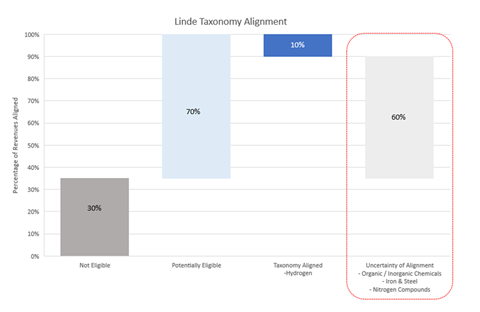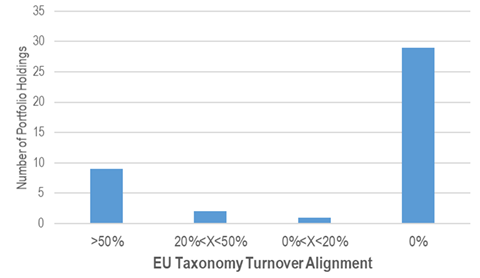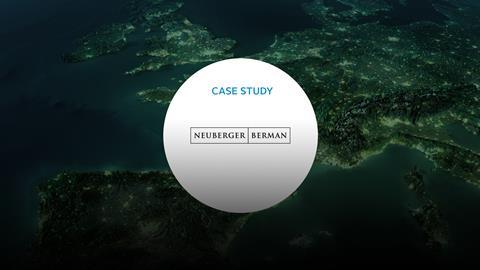| ORGANISATION DETAILS | |
|---|---|
| Name | Neuberger Berman |
| Signatory type | Investment manager |
| Region of operation | Global |
| Assets under management | US$330bn |
| COVERED IN THIS CASE STUDY | ||
|---|---|---|
| Name of fund | NB US Equity Impact | |
| Geography | US | |
| Asset class | Equity | |
| Environmental objective | Mitigation and adaptation | |
| Economic activity | All | |
Neuberger Berman believes the implementation of the taxonomy can help shift global capital flows towards more sustainable economic activities and help prevent the worst consequences of climate change. The world has a finite carbon budget and every year of inaction has serious consequences, so timely implementation of the taxonomy can increase the absolute amount of capital flowing to solutions and raise the cost of capital for companies that are failing to contribute. Company disclosures on these topics, particularly financial exposures to taxonomy-aligned activities, can also be a critical source of information for investors.
Other aspect you would like to mention?
The NB US. Equity Impact strategy is a US-focused public equity investment strategy, but may also be marketed in Europe - so we are conducting the analysis from this perspective.
Taxonomy implementation
Principles, criteria, thresholds
We decided to focus on both principles of the taxonomy, but our analysis was driven by the current portfolio composition, which leans heavily towards climate change mitigation. For the actively managed portfolio of 41 equities as of 6/30/20, we identified any company economic activities that could be potentially aligned with the first two principles of the taxonomy. However, we also examined the four future principles, aiming to prepare for additions. We then evaluated on a company-by-company basis whether the technical criteria for the relevant activity was met. Some 12 of the 41 companies showed aligned economic activities.
By way of example, rail operators were deemed eligible if their trains had zero direct emissions or their emissions per tkm were 50% lower than the average reference CO2 emissions for Heavy Duty Vehicles (HDV), as defined by the EU. From this perspective, the major U.S. rail operators are eligible because trains have considerably lower (~75%) emissions than trucks. The major rail operators all disclosed their CO2 emissions data and ton miles so this could be verified.
On the other hand, rail freight that was dedicated to the transport of fossil fuels was not eligible. For example, 12% of Norfolk Southern (NSC) revenue is derived from transporting coal. We therefore concluded that only 88% of the company’s overall revenue was eligible for the EU Taxonomy.
Do no significant harm assessment
If a company had an activity that was aligned, or potentially aligned, we moved to the next step of evaluating the relevant Do No Significant Harm (DNSH) assessment criteria, supported by primary research and third party data.
The technical report provides four assessment criteria for the freight rail transport sector: adaptation, water, circular economy and pollution. We created a template (exhibit 1) to analyze the companies based on the four criteria, and rated them as green, yellow or red. Green signaled that we were comfortable with the compliance, yellow signaled a lack of data or some reservation, and red signaled a violation due to insufficient policies or past issues.
We were able to conclude that NSC met the first three criteria. However, we found the pollution criteria too specific, because it requires data on engines, noise and speed that the company did not disclose and was not able to subsequently provide, instead offering assurances that it met existing U.S. regulations. Therefore, we were not able to fully assess the fourth criteria. Still, overall we were comfortable that NSC had passed the DNSH criteria.
Social safeguards assessment
The technical report requires an assessment based on eight fundamental conventions identified in the International Labour Organization’s (ILO) declaration on Fundamental Rights and Principles at Work.
We relied on three sources to conduct this assessment: 1) company policies in relation to the eight principles, 2) past instances of complaints or controversies on social topics and 3) third party data such as MSCI for relevant violations.
Again, we applied the green/yellow/red classification and identified one issue on discrimination, relating to a recent Equal Employment Opportunity Commission (EEOC) lawsuit concerning alleged age discrimination. This resulted in a $350k settlement that we classified as a yellow flag.
As neither third parties nor our company identified any severe violations of the eight fundamental conventions, we determined that NSC passed the assessment.
Turnover/capex/opex alignment
In general, we placed greater emphasis on turnover in determining what percentage of the company was aligned with the taxonomy. We found that company disclosure and discussion of the components of turnover were generally more detailed than capex/opex. For example, we considered all turnover of rail operators to be eligible for the EU taxonomy except the portion related to the transport of fossil fuels. For this sector, capex/opex are used to sustain current operations, so we were comfortable turnover alone would be a reliable metric.
Still, in the case of the freight road transport sector, where there is potential to invest in electric heavy duty vehicles (HDVs) over time, we did consider capex to account for potential company shifts earlier than if only evaluating turnover.
Additional comments
In some cases, DNSH criteria can be more challenging than technical criteria, because companies are reluctant to disclose this information to investors. For example, in the rail industry, a maximum noise level consistent with EU regulations is required, but this measurement is unfamiliar to U.S. rail companies. We made a decision that NSC complied with all local regulations and therefore met the criteria.
We were concerned that there is the potential for companies to only focus on improving their disclosure around the alignment of economic activities to the relevant technical criteria, while failing to adequately address DNSH criteria, thus creating a challenge for accurately verifying overall portfolio alignment.
Alignment results
The portfolio has 41 holdings with various weights. After thorough evaluation of the technical screening criteria, DNSH assessments and minimum social safeguards, we determined that 20% of the asset-weighted revenue within the portfolio is aligned with the EU taxonomy. A further 1% of the portfolio is potentially aligned with the first two principles. However, due to a lack of disclosure we were unable to determine at this time if the economic activities of the company fulfilled the technical screening criteria. In some cases, the companies themselves were not aware of the taxonomy or were reluctant to provide the necessary detail to determine if the activity was eligible.
We believe an additional 3% of the asset-weighted revenue in the portfolio is potentially eligible under the four principles of the taxonomy that will be defined in 2021. This includes economic activities such as packaging, precision agriculture and pollution reduction systems.
This exercise demonstrated that a bottom-up evaluation of taxonomy alignment is possible, but there will be gaps in company disclosure of either segment level financial information or economic activity information, as it relates to technical screening criteria. This U.S. Equity Impact strategy could be eligible for an EU Ecolabel at a future date, assuming that the thresholds in draft consultation are implemented at a minimum 18% of asset-weighted revenue/capex/opex exposure.
| US players | CSX | UNP | NSC | KSU |
| Sources: Company disclosed data, EU Taxonomy Report: Technical Annex, MSCI | ||||
| Revenue from transporting coal | 14.2% | 14.5% | 12.4% | 0.1% |
| Revenue eligible for taxonomy | 85.8% | 85.5% | 87/6% | 99.9% |
| DNSH - adaptation | ||||
| DNSH - water | ||||
| DNSH - circular economy | ||||
| DNSH - pollution | ||||
| Social safeguards - 8 conventions | ||||
| Social safeguards - controversies | ||||
Exhibit 2: US industrial gas revenue alignment potential

Source: Neuberger Berman, company disclosed data, EU Taxonomy Report: Technical Annex
Exhibit 3: Neuberger Berman US Equity Impact portfolio alignment distribution

Source: Neuberger Berman, company disclosed data, EU Taxonomy Report: Technical Annex
Challenges and solutions
| NO. | CHALLENGE | SOLUTION |
|---|---|---|
| 1 | The particular threshold is not clear or easily accessible. For example, for freight rail transport, trains are eligible if direct emissions per tkm are 50% lower than average reference emissions of HDVs, as defined by the EU. We were unable to locate this reference point. | We assumed the reference point to be the average emissions of HDV trucks. As trains have ~75% less emissions on average than trucks, we considered the criteria fulfilled. |
| 2 | Some companies’ activities enable other firms’ activities that may be eligible under climate mitigation, but second degree technical information is not available; e.g. ammonia production is enabled by APD/LIN engineering and technology, but it is unclear whether EU thresholds for taxonomy alignment are met. | Revenues from enabling activities for which there are no disclosures around technical performance vs. threshold were labelled as “potentially aligned”. |
| 3 | Initial screening on the NACE or Standard Industrial Classification (SIC) code for potential alignment is challenging given the misclassification of businesses that perform relevant business activities. | We implemented a company-by-company analysis to evaluate revenue disclosures that were either not official segments or misclassified by NACE or other codes. |
Recommendations
In jurisdictions outside Europe, awareness of the taxonomy’s technical screening criteria is significantly lower, so relevant disclosure is lacking and companies may be more reluctant to provide information that they have not previously provided to investors. In order to conduct a company specific analysis, engagement with portfolio companies will be required at this point. Being forthright and transparent around the technical and DNSH criteria may accelerate the process.
While multinationals in the U.S. may be aware of EU regulations referenced in the taxonomy, this potentially is not the case for U.S. domestic firms, who may find them more challenging when assessing compliance.
For investors, sector screening tools built on NACE codes, Global Industry Classification Standards (GICS) or others can only be a starting point, as performance on technical screening criteria can vary so widely within a sector. Additionally, businesses or segments within a business may be subject to a broad-brush approach, missing potentially aligned revenue opportunities.












